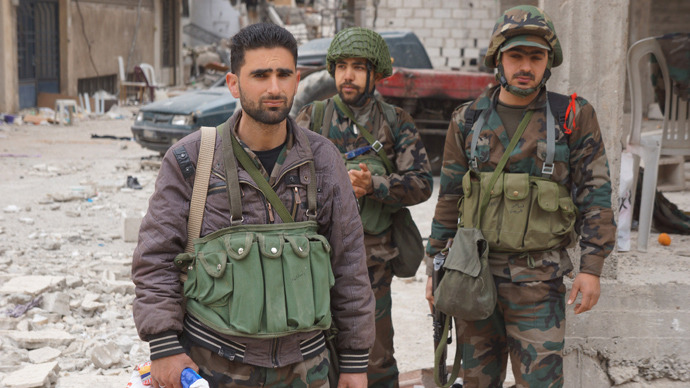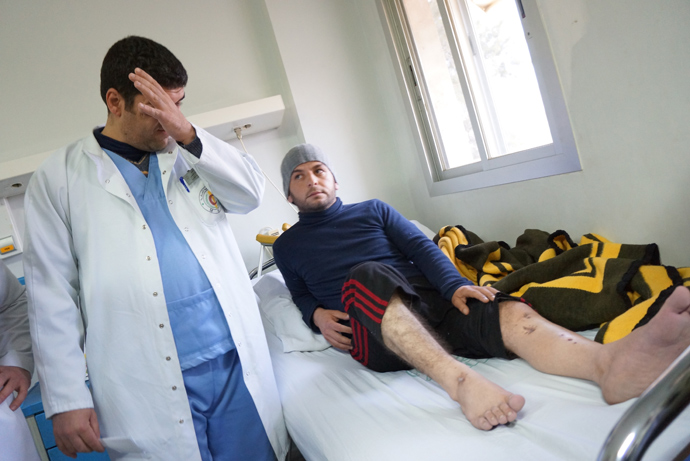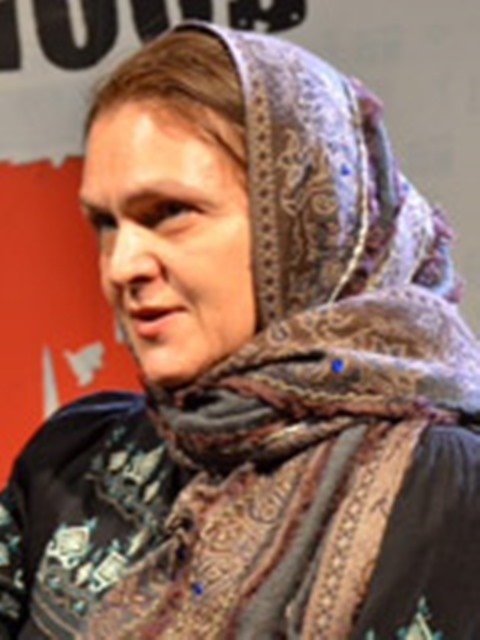Darayya, Syria’s Stalingrad

Two years of ruthless warfare have transformed rookie soldiers of the Syrian army into battle-thirsty experienced veterans. Quiet confidence has replaced a gloomier outlook as soldiers expect to fight the war to the bitter victorious end.
After you leave the silk-stocking downtown of Damascus, passing
by posh mansions, premises of the Ministry of Foreign Affairs and
the Government, driving past a bus stop and a taxi station where
most people hire transport in order to get to Beirut, past endless
food stalls and green grocers and turn left – right after the
checkpoint - you'll find yourself on a highway that leads to
Darayya.
This Damascus suburb is dubbed differently, depending on the life experience of the person describing it: the town of Zero, Syria’s Stalingrad, the city of the dead and so on.

Mezzeh airbase, which hosts a military unit that is in charge of Darayya, is located nearby.
Its commander asks not to take photos of him, joking he is a General, although he is a colonel at most. Missile-armed unit, air defense and tank units are also located not far from the airbase.
The headquarters look exactly like a regular work-place: there are nice armchairs and sofas, but at the same time there is something that reveals this place as host to soldiers – Kalashnikov assault rifles on the floor leaning against homelike bedside tables and somebody’s personal belongings neatly piled in the corners of the room. Japanese dwarf trees in flowerpots have withered long ago, and pot plants – so typical of any office space – are covered with dust. A candle end tells us about occasional power failures, but fortunately it is a rare occurrence – there is only one candle, last lit a long time was ago.
Tried-and-true soldiers
Looking at this military unit one could say that a war serves an
army well. Dress code is free: one is wearing a bright red belt
with a huge buckle, another has a cowboy hat on his head and many
are wearing baseball caps. They move quickly and deftly –
professional machines of war with cat-like grace. They understand
each other without words. There is no servility, neither is there
the beadledom that was so noticeable just two years ago. War
creates the atmosphere of battlefield brotherhood and clears up the
goals.
Several officers come back with a huge basket of oranges.
Greengroceries are located in the vicinity, right outside the
territory of the unit. In fact, it looks like just 200 meters away
from the unit base people live normal ordinary lives – there are
nice houses, streets are crowded with women and kids. From time to
time the picture is interrupted by the sound of shooting and
ambulance sirens.
Only concrete blocks painted orange and black, watch boxes fortified with sandbags, and round-the-clock cannonade signify there is war.
I can’t help making comparisons with those soldiers I saw in the summer 2011 – the very beginning of the events in Syria. Back then they looked like perplexed unskilled youngsters that had no idea of what they had to do and resembled live unarmed targets, put out across the country to be killed. Many of them are now bearded with long hair. You won’t see a tiny bit of that depression in their eyes that was there two years ago.
All those who hadn’t felt like struggling, escaped from the army during these hard two years. But those who have stayed are definitely ready to fight and give away their lives.

Saving Syria on their minds
When talking to the officers and soldiers you don’t get the
image you expected. For instance, the soldiers don’t think they
fight for Assad or the Arab Socialist Baath Party, let alone the
Alawites or power in general.
“We are not fighting for Assad or the Arab Socialist Baath Party. We fight for Syria, which they intend to change. We are against the presence of Qatar and other Gulf states here”, the commander says.
“We are fighting for Syria, for our way of life – when all
the communities join hands. The other side only displays bigotry
and is not looking for solidarity”, another officer
announces.
“Why do they call us non-believers? We don’t meddle with each other’s religions, and treat one another with respect as is customary in Syria. There are Sunnis, Shia, Druzes, Orthodox believers and Maronites among us. One of my friends who was a Sunni and who was performing Salah five times a day died”, a young member of a tank crew says. A few days ago he managed to escape his burning tank and was shell-shocked. Although it was not a must, he returned to duty.

Questioning Islamists’ faithfulness
“I don’t get it, why the West is backing in Syria something
that is illegal in the West. Why do they support terror? We have
seen those who fight against us: they blow up and murder peaceful
civilians. They don’t care about Syria. The West is trying to
present all Muslims without distinction as bloodthirsty murderers –
it doesn’t matter what reasons they kill for”, a bearded chap
says. Not every militant can boast of such a
beard.
“Alcohol and drugs are prohibited in our unit”, an Orthodox soldier named Hani says.
In Syria trying to find out about someone’s religious beliefs in a conversation is considered bad manners. But if you explain why you want to know, people will tell you.
A more talkative soldier is surprised that people outside Syria aren’t comprehending what he and his comrades are fighting for.
“These people who came here to destroy know nothing about our lives. They don’t understand that here churches and mosques are right next to each other. They opened fire at Saidnaya monastery, killed Christians in Maaloula. They destroy churches and mosques – they even mine mosques!” he says.
They think they are fighting against fanatics. Soldiers saw the videos of the rebels mutilating bodies, cutting their heads off, executing people – and they can’t understand why this is called the Sharia law.

Here in the military unit the rumors that the Syrian Armed
Forces are ready to use chemical weapons seem like a hoax not only
because the officers deny it, but also because there are no gas
masks or protective clothing around here. Besides, the country is
too large, with clans and communities too intermingled, to commit
such an act. It’s nothing short of suicide.
The Darayya operation
The head of the unit says that the Darayya operation started in November 2012. The population left back when the militants came. Now the government forces took back control over 75% of the area. Before the war 80 thousand people lived here. It was a rich town, famous for its trade in office supplies. The majority of the population was Sunni, but there were Christians, too.

It’s no accident that the rebels came to this area – they thought wealthy Sunnis would side with them. They killed the government officials and burnt the Mayor’s office. They distributed flyers. But the people started complaining, asking the government to protect them. Eventually, they left their homes.
The chain of events is always similar – refugees from other
parts of the country that ended up in Turkey, Lebanon, or Russia,
all tell the same story.
Some of Darayya’s residents are now living with their relatives,
the rest receive help from the government.
It’s worth mentioning that neither the UN, nor the EU, nor the Arab
countries have launched programs aimed at helping the internally
displaced persons in Syria.
Operational art urban battle
Officers describe the militants’ tactics in detail – it’s the
knowledge that all of them had to acquire as quickly as possible.
The militants come to a district, then start going from flat to
flat, from house to house through the basement level. It is said
that after Darayya was retaken the government forces discovered a
5km long underground route.
It was the first time the Syrian Armed Forces saw this type of urban warfare. No military academy teaches it. It’s only the Israeli army that uses it and only against Palestinians, trying to inflict maximum damage. The Syrian Army was trained to fight against Israel, but it uses predominantly the methods and tactics employed in a war against a regular army.
“They break down walls in the flats and move through them from flat to flat, from house to house. Sometimes we have to fight for every room. It’s permanent fighting, a close contact kind of war”, one officer says.

The government forces have only the military equipment produced in Russia. The rebels have American and Israeli communication systems, American and Western arms.
The soldiers believe they are fighting against several different groups. There are a number of well-trained fighters with useful skills. And then there are the recruits, who most often get killed or taken prisoner.
“When we tune in to their frequency we hear them wonder whether the Chechens are with us”, the officer laughs. There were no Chechens taken prisoner in Syria, but the myth that they are taking part in this war lives on.
War graffiti and myths
They show me agraffiti that was presumably written by our compatriots. It says “Syria today, Russia tomorrow” written with glaring spelling mistakes, so it doesn’t convince me. The literacy rate among Chechens is very high – they write in Russian without any mistakes. Chechens from the immigrant families usually know several languages very well.

I don’t rule out the possibility that the graffiti was meant to perpetuate the myth about a “Chechen squadron”. But the faded graffiti on the shutters of a once-expensive store that says “Close it or die” is a very real one. It seems the owner didn’t close his shop in time...
There is no looting, though, either by the army or the opposition forces. Admittedly, there isn’t much left after the intense fighting.
Some of the graffiti depict cartoon versions of Putin and Assad bathed in their own blood. There are some indecent words, too, but the officers ask us not to take pictures of them and refuse to translate.
Every war spawns its myths, and this one is no exception. But
where do myths end and truths begin?
Myth one is that the militants never leave their dead soldiers’
bodies behind - that they even use a system of ropes to
retrieve them from the battlefield, or that they burn the bodies
down to render them unidentifiable . Some say they have seen the
burnt bodies with their own eyes…
Some myths are ridiculously grotesque – that allegedly only the
most unenlightened and unaware persons volunteer to become
militants and that they believe they are actually in Palestine
fighting against Israel. Some said that when captured, militants
turned out to be from Bangladesh or elsewhere in Asia and that they
couldn’t read Arabic and had no idea they were in Syria...
‘Give us modern Russian weapons’
Army officers say that the militants have a lot of trained
snipers equipped with quality American rifles. Some can hit
the target up to 1,800 meters away.
They shoot at civilians, such as children and random bypassers,
shifting the blame for these losses on the Syrian Army. This is
testimony of the refugees who told me their stories. Many of them
had to flee because of such sniper ops and religious
cleansing.
Interestingly, the militants themselves spread the same kind of
gossip about the adversary – about the illiterate soldiers, about
cruelty and the Revolutionary Guards snipers, although they don’t
go into detail as to why the latter would shoot at Syrian citizens
while fighting for Syria...
“They are very well trained – we can see it by how they take
up positions, take action and leave. We have been trained to run
military operations, not urban ops that we’re forced to run
now,” say the officers. They admit they have suffered losses,
big losses at first.
According to the main military hospital’s medical superintendent, the army sustained losses of over 6,000 people over the first year of war. They say that these days 15 to 20 Syrian military and a few dozen militants die every day. In line with that, two wounded were checked in at a military hospital over the hour that I spent there talking.
The opposition however maintains a different count: a few
casualties among their own and dozens of the military and hundreds
of civilians.
The officers say, “It will be a long war. But our soldiers
maintain high spirits. Only give us the modern weapons. We are
proud to have the Russian weapons. But unfortunately we only have
the old issue. Yet even that it works well.”
Some facts have no explanation.
A tank was destroyed recently by a Russian RPG-29 launcher known
as a “Vampire.” The officers showed me the burnt remains of the
vehicle pointing out the tank turret that was simply blown off.
The fact, however, is: there are no RPG-29s in the Syrian army. And
yet, the Syrian opposition is operating them...
Exterminatory war: neither side takes prisoners
“This war takes no prisoners,” says another colonel
showing me around the ruins of Darayya. – “The other side takes
no prisoners either – they cut our guys’ throats.”
There are many myths about Darayya: some say the army destroyed
the town and its entire population; others say the army bombed it
from the air. But it takes a walk through the town’s streets to see
how the action unrolled. While the outskirts feature wreckage
indicative of air strikes, the town streets are the epitome of
urban warfare. You can see where the sniper was located and how the
other side had tried to take him out. You clearly see where the
fight broke out and where it was at its worst.
Syrian Army soldiers had to master the urban warfare tactics on
the go – they showed me holes in the walls and passages they made
to surround the enemy.

Suddenly I heard the dogs howling at a distance – a very rare
thing in Syria. This probably means they found something to feed
on. The howling stopped as abruptly as it started.
How many militants were there in Darayya? Some say 1,500. Others
said 3,000. One army officer said that 5,300 militants were killed
here over the last six months.
How many are still out there? Some say a thousand... Others
claim that militants keep coming here on a mission to die in
combat...
The army believes that the Darayya operation became the first
one where the army successfully managed to draw the noose tight
around the enemy forces. Previously, the militants’ tactics were to
use the local population as a human shield which forced the army to
give them the opportunity to leave. This time, the locals had left
and so the army had their hands untied. This way Darayya came to
symbolize victory for them.
Just like Stalingrad in World War II – completely destroyed yet
victorious.
“They want to turn all of Syria into a land of ghost towns like this. But we won’t let them!” says the commanding officer.
They say, in a war, it’s about perseverance vs. ideas. Darayya
is definitely about perseverance.
As for the ideas, which one will prevail?
Nadezhda Kevorkova, Damascus
The statements, views and opinions expressed in this column are solely those of the author and do not necessarily represent those of RT.
The statements, views and opinions expressed in this column are solely those of the author and do not necessarily represent those of RT.













